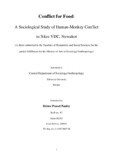Please use this identifier to cite or link to this item:
https://elibrary.tucl.edu.np/handle/123456789/2779| Title: | Conflict for Food: A Sociological Study of Human-Monkey Conflict in Sikre VDC, Nuwakot |
| Authors: | Pandey, Bishnu Prasad |
| Keywords: | Sociological;Study;Human;Monkey |
| Issue Date: | 2014 |
| Publisher: | Central Department of Sociology and Anthropology |
| Abstract: | Human-monkey interactions are descended from the human civilization. Some generalist and most adaptive species of wildlife can adapt in, or nearby human settlement or farmland, where they are using easily accessible food materials. Primates are the frequent crop-raiders in Nepal and Assamese monkey has no exception. This study was carried out in proposed buffer zone of Shivapuri Nagarjun National Park and targeted to access the human and primate interaction. Particularly, assessment of the crop preference, quantity of crop loss and costs of crop damage were the main objectives. Samples were drawn randomly by lottery method and field observation, structured and un-structured interview with 12.8 % household was made. Simple mathematical tools were used to analyze the data and results were presented by texts, tables, and figures. The study reveals that there is a mosaic of ethnicity and fairly uniform religious belief. Majority of households (80%) are headed by male and diversification of occupation was observed. On an average each households have 5.8 members with standard deviation of 2.15. 30% populations are illiterate while 30% have only primary education and 40 % secondary education. It was found that each house hold has 8.85 Ropanies of farm land. Shifting of occupation could be boosted by low agricultural productivity and frequent crop raids in areas of close to the national park. The distance between farmland and forest has a negative co-relation values (r = -0.5, -0.6, and -0.7) while the distance between farmers’ house and farmland has positive relations (r = 0.07, 0.1, and 0.14) on Doyam, Sim, and Chahar land respectively. It was found that maize was the top favored crop followed by millet, Skhush, beans, pumpkin, and rice while wheat was heavily damaged during winter followed by radish, potato, and mustard. Uprooting by infants and juveniles for curiosity and play is common. Maize was highly damaged by 77 kgs, millet 56 kgs in summer while wheat was top raided by 38 kgs, radish 24 kgs, and potato 13 kgs per family in winter. Banana was frequently raided (12 kgs). The mean cost paid by local farmer for crop damage was NRs 5933 per family while cost of crop protection tolls NRs 6602. The area of land and cost of crop raid has highly correlated (r value: 0.8) in study area. |
| URI: | http://elibrary.tucl.edu.np/handle/123456789/2779 |
| Appears in Collections: | Sociology |
Files in This Item:
| File | Description | Size | Format | |
|---|---|---|---|---|
| Bishnu Pd. Pandey_Conflict for food_A Sociological Study of Human Monkey Conflict in Sikre VDC, Nuwakot.pdf | 889.94 kB | Adobe PDF |  View/Open |
Items in DSpace are protected by copyright, with all rights reserved, unless otherwise indicated.
